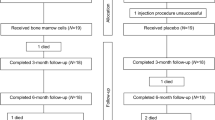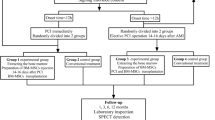Abstract
Aims
In the placebo-controlled, double-blind BOne marrOw transfer to enhance ST-elevation infarct regeneration (BOOST) 2 trial, intracoronary autologous bone marrow cell (BMC) transfer did not improve recovery of left ventricular ejection fraction (LVEF) at 6 months in patients with ST-elevation myocardial infarction (STEMI) and moderately reduced LVEF. Regional myocardial perfusion as determined by adenosine stress perfusion cardiac magnetic resonance imaging (S-CMR) may be more sensitive than global LVEF in detecting BMC treatment effects. Here, we sought to evaluate (i) the changes of myocardial perfusion in the infarct area over time (ii) the effects of BMC therapy on infarct perfusion, and (iii) the relation of infarct perfusion to LVEF recovery at 6 months.
Methods and results
In 51 patients from BOOST-2 (placebo, n = 10; BMC, n = 41), S-CMR was performed 5.1 ± 2.9 days after PCI (before placebo/BMC treatment) and after 6 months. Infarct perfusion improved from baseline to 6 months in the overall patient cohort as reflected by the semi-quantitative parameters, perfusion defect–infarct size ratio (change from 0.54 ± 0.20 to 0.43 ± 0.22; P = 0.006) and perfusion defect–upslope ratio (0.54 ± 0.23 to 0.68 ± 0.22; P < 0.001), irrespective of randomised treatment. Perfusion defect–upslope ratio at baseline correlated with LVEF recovery (r = 0.62; P < 0.001) after 6 months, with a threshold of 0.54 providing the best sensitivity (79%) and specificity (74%) (area under the curve, 0.79; 95% confidence interval, 0.67–0.92).
Conclusion
Infarct perfusion improves from baseline to 6 months and predicts LVEF recovery in STEMI patients undergoing early PCI. Intracoronary BMC therapy did not enhance infarct perfusion in the BOOST-2 trial.
Graphic abstract





Similar content being viewed by others
References
Szummer K, Wallentin L, Lindhagen L, Alfredsson J, Erlinge D, Held C et al (2017) Improved outcomes in patients with ST-elevation myocardial infarction during the last 20 years are related to implementation of evidence-based treatments: experiences from the SWEDEHEART registry 1995–2014. Eur Heart J 38(41):3056–3065
Zahler D, Lee-Rozenfeld K, Ravid D, Rozenbaum Z, Banai S, Keren G, Shacham Y (2019) Relation of lowering door-to-balloon time and mortality in ST segment elevation myocardial infarction patients undergoing percutaneous coronary intervention. Clin Res Cardiol. https://doi.org/10.1007/s00392-019-01438-6
Mamas MA, Anderson SG, O'Kane PD, Keavney B, Nolan J, Oldroyd KG et al (2014) Impact of left ventricular function in relation to procedural outcomes following percutaneous coronary intervention: insights from the British Cardiovascular Intervention Society. Eur Heart J 35(43):3004–3012
Ibanez B, James S, Agewall S, Antunes MJ, Bucciarelli-Ducci C, Bueno H et al (2018) 2017 ESC Guidelines for the management of acute myocardial infarction in patients presenting with ST-segment elevation: the Task Force for the management of acute myocardial infarction in patients presenting with ST-segment elevation of the European Society of Cardiology (ESC). Eur Heart J 39(2):119–177
Backhaus SJ, Kowallick JT, Stiermaier T, Lange T, Koschalka A, Navarra JL et al (2019) Culprit vessel-related myocardial mechanics and prognostic implications following acute myocardial infarction. Clin Res Cardiol. https://doi.org/10.1007/s00392-019-01514-x
Hodgkinson CP, Bareja A, Gomez JA, Dzau VJ (2016) Emerging concepts in paracrine mechanisms in regenerative cardiovascular medicine and biology. Circ Res 118(1):95–107
Wollert KC, Drexler H (2010) Cell therapy for the treatment of coronary heart disease: a critical appraisal. Nat Rev Cardiol 7(4):204–215
Fisher SA, Zhang H, Doree C, Mathur A, Martin-Rendon E (2015) Stem cell treatment for acute myocardial infarction. Cochrane Database Syst Rev 9:CD006536
Wollert KC, Meyer GP, Muller-Ehmsen J, Tschope C, Bonarjee V, Larsen AI et al (2017) Intracoronary autologous bone marrow cell transfer after myocardial infarction: the BOOST-2 randomised placebo-controlled clinical trial. Eur Heart J 38(39):2936–2943
Puntmann VO, Valbuena S, Hinojar R, Petersen SE, Greenwood JP, Kramer CM et al (2018) Society for Cardiovascular Magnetic Resonance (SCMR) expert consensus for CMR imaging endpoints in clinical research: part I—analytical validation and clinical qualification. J Cardiovasc Magn Reson 20(1):67
Hussain ST, Morton G, De Silva K, Jogiya R, Schuster A, Paul M et al (2017) The assessment of ischaemic burden: validation of a functional jeopardy score against cardiovascular magnetic resonance perfusion imaging. Clin Res Cardiol 106(4):259–270
Kramer CM, Barkhausen J, Flamm SD, Kim RJ, Nagel E, Society for Cardiovascular Magnetic Resonance Board of Trustees Task Force on Standardized P. Standardized cardiovascular magnetic resonance (CMR) protocols (2013) update. J Cardiovasc Magn Reson 2013(15):91
Youden WJ (1950) Index for rating diagnostic tests. Cancer 3(1):32–35
Bethke A, Shanmuganathan L, Shetelig C, Swanson D, Andersen GO, Eritsland J et al (2018) MR findings of microvascular perfusion in infarcted and remote myocardium early after successful primary PCI. PLoS ONE 13(11):e0206723
Wong DT, Leung MC, Das R, Liew GY, Williams K, Dundon BK et al (2011) Diagnostic accuracy of adenosine stress cardiovascular magnetic resonance following acute ST-segment elevation myocardial infarction post primary angioplasty. J Cardiovasc Magn Reson 13:62
Wong DT, Leung MC, Richardson JD, Puri R, Bertaso AG, Williams K et al (2012) Cardiac magnetic resonance derived late microvascular obstruction assessment post ST-segment elevation myocardial infarction is the best predictor of left ventricular function: a comparison of angiographic and cardiac magnetic resonance derived measurements. Int J Cardiovasc Imaging 28(8):1971–1981
Bethke A, Shanmuganathan L, Andersen GO, Eritsland J, Swanson D, Klow NE et al (2019) Microvascular perfusion in infarcted and remote myocardium after successful primary PCI: angiographic and CMR findings. Eur Radiol. 29(2):941–950
Robbers LF, Nijveldt R, Beek AM, Hirsch A, van der Laan AM, Delewi R et al (2014) Cell therapy in reperfused acute myocardial infarction does not improve the recovery of perfusion in the infarcted myocardium: a cardiac MR imaging study. Radiology 272(1):113–122
Janssens S, Dubois C, Bogaert J, Theunissen K, Deroose C, Desmet W et al (2006) Autologous bone marrow-derived stem-cell transfer in patients with ST-segment elevation myocardial infarction: double-blind, randomised controlled trial. Lancet 367(9505):113–121
Sezer M, van Royen N, Umman B, Bugra Z, Bulluck H, Hausenloy DJ et al (2018) Coronary microvascular injury in reperfused acute myocardial infarction: a view from an integrative perspective. J Am Heart Assoc 7(21):e009949
Niccoli G, Scalone G, Lerman A, Crea F (2016) Coronary microvascular obstruction in acute myocardial infarction. Eur Heart J 37(13):1024–1033
Niccoli G, Montone RA, Ibanez B, Thiele H, Crea F, Heusch G et al (2019) Optimized treatment of ST-elevation myocardial infarction. Circ Res 125(2):245–258
van Kranenburg M, Magro M, Thiele H, de Waha S, Eitel I, Cochet A et al (2014) Prognostic value of microvascular obstruction and infarct size, as measured by CMR in STEMI patients. JACC Cardiovasc Imaging 7(9):930–939
de Waha S, Desch S, Eitel I, Fuernau G, Lurz P, Leuschner A et al (2012) Relationship and prognostic value of microvascular obstruction and infarct size in ST-elevation myocardial infarction as visualized by magnetic resonance imaging. Clin Res Cardiol 101(6):487–495
Hsu LY, Jacobs M, Benovoy M, Ta AD, Conn HM, Winkler S et al (2018) Diagnostic performance of fully automated pixel-wise quantitative myocardial perfusion imaging by cardiovascular magnetic resonance. JACC Cardiovasc Imaging 11(5):697–707
Acknowledgements
We would like to thank the following physicians, research assistants, and study nurses for their support of the trial: I. Schridde and S. Tammen (Hannover); E. Erdmann, M. Halbach, B. Krausgrill, and T. Schewior (Cologne); B. Blank (Berlin); W. Bethge (Tübingen); R. Bülow, M. Heukäufer, and T. Neumann (Greifswald); A. Dösch (Heidelberg); and U. Sechtem (Stuttgart). We thank F.J. Neumann (Bad Krozingen) and G. Steinhoff (Rostock) who served as members of the Data and Safety Monitoring Board.
Funding
This work was supported by the German Research Foundation (DR 148/13-1 Programme Clinical Trials), the Alfried Krupp von Bohlen and Halbach-Foundation, and the Robert Bosch Stiftung.
Author information
Authors and Affiliations
Corresponding author
Electronic supplementary material
Below is the link to the electronic supplementary material.
Rights and permissions
About this article
Cite this article
Seitz, A., Wollert, K.C., Meyer, G.P. et al. Adenosine stress perfusion cardiac magnetic resonance imaging in patients undergoing intracoronary bone marrow cell transfer after ST-elevation myocardial infarction: the BOOST-2 perfusion substudy. Clin Res Cardiol 109, 539–548 (2020). https://doi.org/10.1007/s00392-019-01537-4
Received:
Accepted:
Published:
Issue Date:
DOI: https://doi.org/10.1007/s00392-019-01537-4




